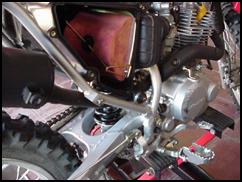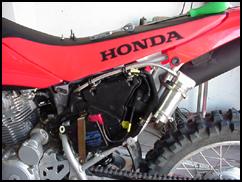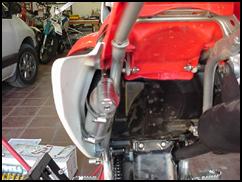Rear Suspension Performance - Project Honda CRF230F - Part 2
Works Performance Rear Suspension
In part one of our project, we let the CRF 230 breathe a bit by opening up the air box and exhaust, the installed the optional jetting. The cost was $37 for all the jets, and dollar for dollar, it was the most improvement that could be gained from the bike. It literally brought the bike alive. But in the process of making the bike much more spirited, the shortcomings of the suspension were rather harshly pointed out. Bumps that were merely tolerated, quickly became rattling, jarring hits to the rear end when we hit them at speed. The bike was returned to the garage and we considered our adjustment options. Hmmm. No compression adjustment. No rebound. Just preload. This meant getting the "sag" correct was all that we could do. Sag is the amount the suspension compresses when you're sitting on the bike in the normal riding position, compared to the fully extended suspension position when the bike is on a stand with the rear wheel in the air. About one-third of the suspension travel is normally the amount of sag with the rear wheel. For example, if your bike has 9 inches of travel, you'll want to dial in 3 inches of sag. This is a ball park number and you might need more or less sag, depending on your riding style and the terrain you ride on. Here's how to dial in your sag: first put your bike on a stand (or a milk crate) so the rear wheel doesn't touch the ground. Measure from the rear axle to a point on the rear fender. This is the extended measurement, or number. You'll need to have someone help you with this next step. Sit on the bike and have a buddy measure the same points as the extended measurement. You'll find a difference in the measurement … and this is the sag. On the 230 Honda, 3 inches works out about right. If you have more than 3 inches, you need to crank up the shock spring preload. If you have less than 3 inches, then you don't have enough sag, and you need to reduce the shock preload. To adjust the shock preload, you need to loosen the jam nut on the top of the shock. Use a heavy hammer and a blunt-tipped drift to loosen the top jam nut, then turn it counterclockwise, until you can see some space between the top jam nut and the bottom jam nut, the screw it up the shock body.
Ride the bike again, and then you'll probably do what we did. No matter how much we fiddled with the preload, the shock still left a lot be desired. Sure, the bike was acceptable on smooth dirt roads, but then, so is a Buick. We opted for a replacement shock. Two stages of tuning are available from Works Performance for the Honda CRF230F. Both the shocks available for this bike are mono-tube designs that incorporate Works' unique check ball, spring and orifice valving system. This design allows the high, medium and low speed damping circuits to be modified independent of each other. The shocks are nitrogen charged and equipped with a bladder-style reservoir. They each feature threaded spring preload and 18-position rebound adjustment. The Pro Series shock also has 22-position adjustable compression. The shocks are all built to order to specific rider weights and intended use. Each unit is covered with a 30-day Ride Quality Guarantee. If the rider feels the shock is too stiff or too soft, Works will re-valve and re-spring the shock as necessary without charge except for shipping. When the rider gets the shock back, another 30-day period begins. This is done to make sure that the shock meets all the objectives of the rider. The shocks are covered with a 90-day warranty against parts and materials defects whether or not it is used in competition. Because of the linkage design and packaging requirements, the shock design allows a modest increase in travel from 8.6-inches (actual travel) to 9.2-inches. The shocks are also equipped with an adjustable length feature that allows the ride height to be raised or lowered without changing the spring pre-load. This is referred to as adjustable ride height. Construction features that pertain to both of the shocks for the 230F: 5/8-inch diameter, hard-chromed, induction hardened, high-tensile steel shaft; steel pressure tube welded to a steel body eye casting; spring wound from chrome silicon wire, shot-peened, set to solid and powder coated; and other metal components are machined from billet aluminum or cold-rolled steel (grade depends on component). All the shocks are fully re-serviceable and all individual parts are available to the customer. Shock 1-- Adjustable Gasser Remote. Hose mounted reservoir shock with 18-position adjustable through-the-shaft rebound and adjustable ride height. Allows adjustment for conditions: terrain changes, more whoops, preload changes, etc. Designed for heavy-duty use. Direct bolt-on. Retail price: $449.00 each. Shock 2-- Adjustable Pro Series. Similar to the Adjustable Gasser Remote shock above, except equipped with a 22-position adjustable compression reservoir. Designed for heavy-duty use. Retail price: $529.00 Works also offers a similar pair of shocks for the CRF150F and for virtually all small displacement bikes from backyard minis (special springing and valving setups are available for riders up to 240 lbs), to 85cc mini competition. Works makes shocks for nearly all dirt bikes from present day back to the late sixties. A catalog and dirt bike application guide are available for $3.00. Much of the same material is available online at the Works Performance website. Source: After bolting the new shock (we used the adjustable Pro Series) on, the bike was taken for a ride. The difference in the action of the rear end was incredible! Since I weigh around 200 pounds, the stock shock was near its limits even under casual riding conditions. Lest you think that lighter riders would be happy with the stock shock, be aware that my old buddy Tom bought a new CRF 230 and was griping about the rear suspension. He weighs about 150. The amazing thing was that I never made any pre-load, or damping adjustments before I rode the bike, and I don't think I'll do any until I need them. A call to Ned Owens at Works confirmed our suspicions; the shock was set up for my body weight. Perfectly. While the Works shock is a bit pricey, it's definitely worth the price. Rather than spending money on all sorts of sticker kits and light weight goodies, the shock swap is a must if you want a decent bike. With the rear end working properly, the shortcomings of the front end became apparent. We'll have to do something about that in the near future. Installing the new shock and removing the old was a real pain. The job required removing a lot of stuff and having a bunch of different blocks to place under the rear wheel to position it properly. For that reason, we've included step-at-a-time photos and captions for those who choose this route. We're well on our way to making a great bike out of a good one. Stay tuned.
|

































 Your Privacy Choices
Your Privacy Choices